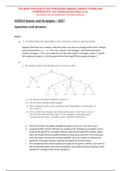FOR MORE HIGH-QUALITY PAST PAPER MODEL ANSWERS, ONLINE TUTORING AND
ECONOMICS HELP, visit LondonEconomicsTutors.co.uk.
Discounted prices compared to all other websites
ECN214 Games and Strategies – 2017
Questions and Answers
Part A
1)
Suppose that there are n players, and each player can play any strategy within their strategy
space denoted by S1, S2, …, Sn. Then, for a player i, the strategy si’ will strictly dominate
another strategy si’’ if for any combination of the other player’s strategies, player i’s payoff
from playing strategy si’ is strictly greater than their payoff from playing strategy si’’.
2)
a. The list of all pure strategies available to player A are: (a,h), (a,i), (b,h), (b,i).
b. A payoff profile is Pareto efficient if a change in the strategy of one player cannot
improve the payoff for one player without reducing the payoff for another player.
Here, the Pareto efficient payoff profiles are (6,2), (8,1), and (5,3). This is because
once the players achieve one of these payoffs, there are unable to improve the
payoff for one player without reducing the payoff for another player.
c. The sub-game perfect Nash equilibrium outcome of a game is where, if we were to
split the dynamic game into many sub-games, each player would be playing a Nash
equilibrium strategy within those sub-games.
, FOR MORE HIGH-QUALITY PAST PAPER MODEL ANSWERS, ONLINE TUTORING AND
ECONOMICS HELP, visit LondonEconomicsTutors.co.uk.
Discounted prices compared to all other websites
We first consider the game that is played after player A has chosen the strategy b.
We can consider this sub-game a simultaneous-move game. Suppose that player A
always chooses strategy (i) within this sub-game. Then, Player B will choose a
strategy that will maximise their payoff. Suppose that they choose to play strategy
(f), and receive a payoff of 2. Given that Player A always plays (i), Player B cannot
improve their payoff above 2, and will therefore not wish to change strategies.
Given that Player B always plays (f), Player A cannot increase their payoff by
switching strategies, and will therefore not wish to change strategies. Therefore, this
is a Nash Equilibrium for this sub-game where the players receive (6,2).
We now consider the sub-game that is player after Player A chooses (a). The optimal
strategy for Player B is to play (c). Since they cannot improve their payoff by
choosing (d), this is a Nash equilibrium for this subgame, where the players receive
(6,1).
Now considering the game as a whole. Player A has the choice of choosing (a),
where the players receive (6,1), or (b), where the players receive (6,2). They are
indifference between these two choices, as they receive the same payoff in both.
Therefore, a subgame-perfect Nash equilibrium is where Player A plays the strategy
(b, i) and Player B plays (c, f).
d. This is an imperfect information game. This is because when Player A is making their
strategic decision, they are not fully aware of what strategy Player B has played
previously.
3)
a. There is one pure strategy equilibrium – this is where player A chooses (m) and
Player B chooses (c), and their payoff is (2,2).
b. If Player B plays strategies (l) and (c) with equal probability 0.5, then the expected
payoff for Player A for each strategy is:
i. (u): 3*0.5 = 1.5




